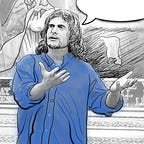Cat Canyon Secrets
There is one sacred act of worship that I perform in secret. Even though I am hiding behind a piece of paper, I still find it embarrassing to confess. It is an act that I perform in total solitude out among the rugged ridges I like to call cat canyons.
Mountain lions prefer rugged canyons, steep gorges and sheer chasms. The muscular cats can cover the vertical terrain swiftly, muscles swelling and melting beneath the tawny yellow fur. Thick forests and massive boulders provide a hunters cover. Ambushes are sprung with powerful predatory leaps, unleashing feline missiles of claw and fang. The big cats go by several names — cougar, puma, mountain lion — like wandering wizards they travel under aliases and like mystic hermits they seek solitude.
You rarely see people in cat canyons and rarely do you find trails. The rugged geology that creates the solitude of a cat canyon, where feline kings recline on granite perches, also creates boulder strewn ribbons of mountain stream, waterfalls adorning the gorges like jewels. Deep pools provide drinking water for the big game who live here; deer, javelina, bighorn sheep, and wild turkey. The cats just grow fatter and fatter.
When cougars travel they like to walk on rock, leaving no scent or trace of their solitary meanderings. On a Sunday afternoon in Soldiers Canyon, recent rains had made the earth soft and yielding, revealing a single feline misstep, an interruption in the series of boulder to boulder launches; a deep crisp paw print, talons digging into the mud.
The first puma I ever saw in the wild was illuminated in the headlights of a pickup truck. The big cat was crossing the road as I was on the way up to Rose Canyon Lake for a sunrise fishing adventure. I have learned since then that sunrise is the best time to see mountain lions, when they are still curious about the day, wandering to select a rock ledge with a good overlook. Sitting Bull, the sacred dreamer of the Sioux, also liked sunrises. Up always before dawn, he liked to walk about in the morning dew, bathing his bare feet. Sitting Bull used to say, “Healthy feet can hear the very heart of the Holy Earth.”
This thing I do, the one I am so embarrassed to talk about I do at sunrise. It involves my most prized possession. I attained it during a quest — like any good object of sacred ritual is found — while searching through the attic of my grandfather. It is my own personal Excalibur — a silver saxophone — the one my grandfather played in speakeasy jazz bands during Prohibition. Out there in the middle of the desert, where I am sure no one can hear me except some nervously chattering coati, I play love songs on my saxophone.
When I stand there atop the ridges of those cat canyons playing my saxophone, I really wail, my #4 alto reed vibrating with feral howls and yowls. I have to play real loud; it takes a lot of wind to inflate the clouds and open the sky until the horizon seems endless. I have to play with a lot of heart too, making the pastel reds, burning oranges, and streaking crimsons; filling the heavens with enough color to hold all the dreams that are still possible with the birth of a new day.
Afterwards I pack my beautiful silver saxophone, gift of my grandfather, into its old case and drive my pickup truck back to my urban existence of jobs, bills, and telephone solicitors. People see me smiling inanely and wonder if I am “normal”. They never, ever know of the secret saxophone sunrise serenades that I perform in cat canyons.
